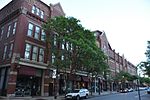Timeline of Manchester, New Hampshire
Commons category link is locally definedDynamic listsHistory of New HampshireManchester, New HampshireNew Hampshire-related lists ... and 2 more
Timelines of cities in the United StatesYears in New Hampshire
The following is a timeline of the history of the city of Manchester, New Hampshire, United States.
Excerpt from the Wikipedia article Timeline of Manchester, New Hampshire (License: CC BY-SA 3.0, Authors).Timeline of Manchester, New Hampshire
Hampshire Lane, Manchester
Geographical coordinates (GPS) Address Nearby Places Show on map
Geographical coordinates (GPS)
| Latitude | Longitude |
|---|---|
| N 42.990833 ° | E -71.463611 ° |
Address
Hampshire Lane
Hampshire Lane
03101 Manchester
New Hampshire, United States
Open on Google Maps








